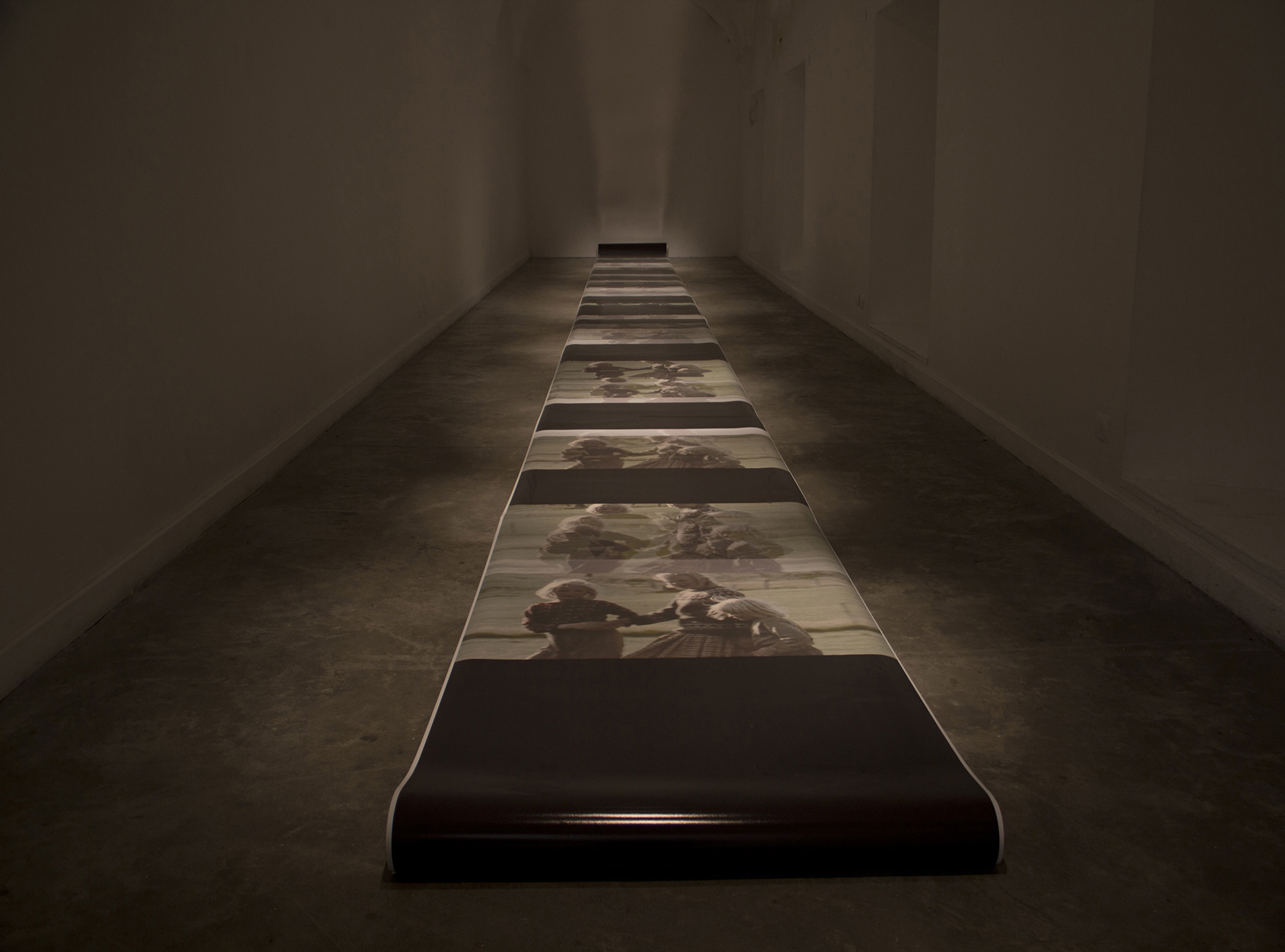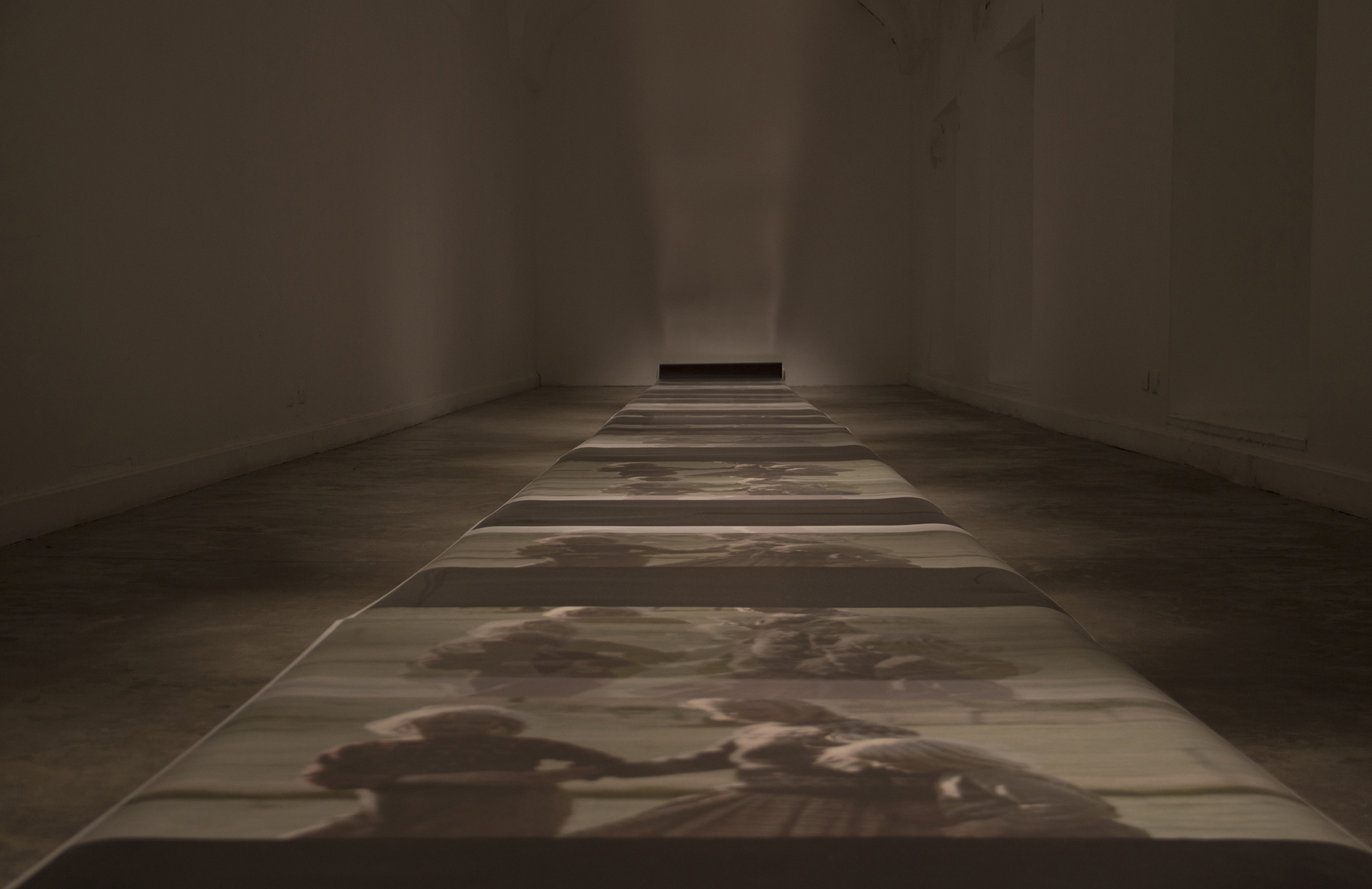Bonheur
2016Sala Prometeus
Centro Cultural Recoleta




Bonheur, la instalación de Magnin es en principio la ocasión de ver el despliegue impecable de las posibilidades que la técnica y sus artefactos ofrecen a la producción de un artista. Pero mucho más allá de esa novedad, la instalación y su sobriedad hacen posible el rescate del olvido de la imagen que el cineasta y documentalista Chris Marker definió como “la imagen de la felicidad”; la de los tres niños en 1965 en un camino de Islandia, con la que inaugura su film Sans Soleil (1982). Los veinte metros de papel fotográfico impresos sin cortes que se despliegan a lo largo de la sala, ya no imponen a quienes la miran la opción de Marker al incluir el fotograma entre dos espacios oscuros: “…si no ven la felicidad al menos verán el negro”.
La instalación reclama un ojo atento, un visionado calmo y dedicado que camine ese largo salón como los tres niños, pero para descubrir la vuelta de tuerca de Magnin: su trabajo ha sido el de extender en el espacio fotográfico y –por lo tanto- en el tiempo, el grano de la luz, habilitar opacidades y luminaridades que suprimen para siempre, al menos en la representación fotográfica, la opción binaria entre la Bonheur y lo negro. En el transcurso de la fotografía desplegada por Magnin, se materializa la impureza de la felicidad, su posibilidad de ser siempre un claroscuro entre lo visible y lo no visible, lo dicho y lo callado, la tranquilidad del paisaje y la inquietud interior. Magnin, como Marker podrían caber en esa bella definición deleuziana sobre los autores de imágenes, “(…) no pueden compararse solo con pintores, arquitectos, músicos, sino también con pensadores. Ellos piensan con imágenes-movimiento, con imágenes-tiempo, en lugar de conceptos”.
En la larga gradación-intervención de la imagen por parte de Magnin, hay dos aspectos importantes que señalar: el modo de interferencia, el lapso, el espacio, el grosor, es al modo de la partitura musical, una composición que siendo aquí silenciosa, produce la irrupción de la memoria en la unión del pasado y el presente. En este espacio de juntura se inscribe nuestro –el de Marker, el de Magnin, el de todo espectador- verdadero yo, ese instante del tiempo fuera del tiempo, donde, lejos de todo proyecto, nos vemos arrojados por un momento a la búsqueda de lo desconocido que siempre se nos escapa. Bonheur es la captura de un fragmento de “tiempo en estado puro”, ajeno a todo proyecto, desprovisto de toda utilidad; es la esencia de un momento que adopta la forma de un recuerdo.
La película de la que Magnin toma sólo algunos fotogramas, es un gran rompecabezas cuya cifra son precisamente esos tres niños, que dicen acerca de la felicidad un mensaje inacabado cuyo centro se desplaza como en los metros de fotografía de Magnin: desde el principio hasta el final, todo cambia, pero en Bonheur lo que cambia –ese tiempo, esa duración- no parece poder captarse sino indirectamente, o como diría Deleuze “en relación con las imágenes-movimiento que lo expresan”. Marker y Magnin son los del montaje virtuoso, el que recae sobre esa sola imagen para desprender de ella el todo, la idea: la imagen del tiempo.
Finalmente, delante de esta fotografía extendida, la pregunta que surge es: ¿un recuerdo es algo que se tiene o la estela de lo que hemos perdido? Quién sabe.
Daniela Gutierrez
1 Precisamente el título del film de Marker, Sans Soleil, remite a una composición musical de Moussorgski
Bonheur, Magnin's installation is in principle the occasion to see the impeccable unfolding of the possibilities that the technique and its artifacts offer to the production of an artist. But far beyond this novelty, the installation and its sobriety make it possible to rescue the forgetfulness of the image that the filmmaker and documentary filmmaker Chris Marker defined as "the image of happiness"; that of the three children in 1965 on a road to Iceland, with which he inaugurates his film Sans Soleil (1982). The twenty metres of photographic paper printed without cuts that unfold throughout the room no longer impose Marker's option on those who look at it by including the frame between two dark spaces: "...if they don't see happiness, at least they will see black".
The installation demands an attentive eye, a calm and dedicated vision that walks that long room like the three children, but to discover Magnin's turn of the screw: his work has been to extend in the photographic space and - therefore - in time, the grain of light, to enable opacities and luminaries that suppress forever, at least in the photographic representation, the binary option between the Bonheur and the black. In the course of the photography displayed by Magnin, the impurity of happiness is materialised, his possibility of always being a chiaroscuro between the visible and the non-visible, the said and the silent, the tranquillity of the landscape and the inner restlessness. Magnin, like Marker, could fit into this beautiful Deleuzian definition of the authors of images, "(...) they cannot be compared only with painters, architects, musicians, but also with thinkers. They think with images-movement, with image-time, instead of concepts".
In Magnin's long gradation-intervention of the image, there are two important aspects to point out: the mode of interference, the lapse, the space, the thickness, it is in the mode of the musical score, a composition that being here silent, produces the irruption of the memory in the union of the past and the present. Our - Marker's, Magnin's, every spectator's - true self is inscribed in this joint space, that instant of time outside of time, where, far from any project, we are thrown for a moment in search of the unknown that always escapes us. Bonheur is the capture of a fragment of "pure time", alien to any project, devoid of any usefulness; it is the essence of a moment that takes the form of a memory.
The film from which Magnin takes only a few stills is a great puzzle whose figure is precisely those three children, who say about happiness an unfinished message whose centre shifts like in the metres of Magnin's photography: from the beginning to the end, everything changes, but in Bonheur what changes - that time, that duration - seems to be captured only indirectly, or as Deleuze would say "in relation to the images-movement that express it". Marker and Magnin are those of the virtuoso montage, the one that falls on that single image to detach from it the whole, the idea: the image of time.
Finally, in front of this extended photography, the question that arises is: is a memory something we have or the wake of what we have lost? Who knows.
Daniela Gutierrez
1 Precisely the title of Marker's film, Sans Soleil, refers to a musical composition by Moussorgski